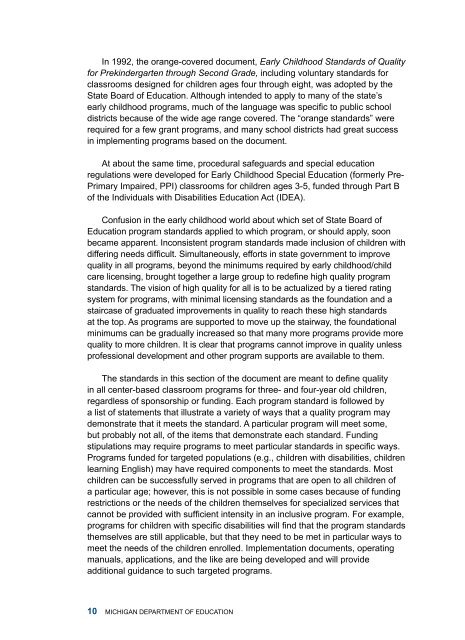Early Childhood Standards of Quality for ... - State of Michigan
Early Childhood Standards of Quality for ... - State of Michigan
Early Childhood Standards of Quality for ... - State of Michigan
Create successful ePaper yourself
Turn your PDF publications into a flip-book with our unique Google optimized e-Paper software.
In 1992, the orange-covered document, <strong>Early</strong> <strong>Childhood</strong> <strong>Standards</strong> <strong>of</strong> <strong>Quality</strong><strong>for</strong> Prekindergarten through Second Grade, including voluntary standards <strong>for</strong>classrooms designed <strong>for</strong> children ages four through eight, was adopted by the<strong>State</strong> Board <strong>of</strong> Education. Although intended to apply to many <strong>of</strong> the state’searly childhood programs, much <strong>of</strong> the language was specific to public schooldistricts because <strong>of</strong> the wide age range covered. The “orange standards” wererequired <strong>for</strong> a few grant programs, and many school districts had great successin implementing programs based on the document.At about the same time, procedural safeguards and special educationregulations were developed <strong>for</strong> <strong>Early</strong> <strong>Childhood</strong> Special Education (<strong>for</strong>merly Pre-Primary Impaired, PPI) classrooms <strong>for</strong> children ages 3-5, funded through Part B<strong>of</strong> the Individuals with Disabilities Education Act (IDEA).Confusion in the early childhood world about which set <strong>of</strong> <strong>State</strong> Board <strong>of</strong>Education program standards applied to which program, or should apply, soonbecame apparent. Inconsistent program standards made inclusion <strong>of</strong> children withdiffering needs difficult. Simultaneously, ef<strong>for</strong>ts in state government to improvequality in all programs, beyond the minimums required by early childhood/childcare licensing, brought together a large group to redefine high quality programstandards. The vision <strong>of</strong> high quality <strong>for</strong> all is to be actualized by a tiered ratingsystem <strong>for</strong> programs, with minimal licensing standards as the foundation and astaircase <strong>of</strong> graduated improvements in quality to reach these high standardsat the top. As programs are supported to move up the stairway, the foundationalminimums can be gradually increased so that many more programs provide morequality to more children. It is clear that programs cannot improve in quality unlesspr<strong>of</strong>essional development and other program supports are available to them.The standards in this section <strong>of</strong> the document are meant to define qualityin all center-based classroom programs <strong>for</strong> three- and four-year old children,regardless <strong>of</strong> sponsorship or funding. Each program standard is followed bya list <strong>of</strong> statements that illustrate a variety <strong>of</strong> ways that a quality program maydemonstrate that it meets the standard. A particular program will meet some,but probably not all, <strong>of</strong> the items that demonstrate each standard. Fundingstipulations may require programs to meet particular standards in specific ways.Programs funded <strong>for</strong> targeted populations (e.g., children with disabilities, childrenlearning English) may have required components to meet the standards. Mostchildren can be successfully served in programs that are open to all children <strong>of</strong>a particular age; however, this is not possible in some cases because <strong>of</strong> fundingrestrictions or the needs <strong>of</strong> the children themselves <strong>for</strong> specialized services thatcannot be provided with sufficient intensity in an inclusive program. For example,programs <strong>for</strong> children with specific disabilities will find that the program standardsthemselves are still applicable, but that they need to be met in particular ways tomeet the needs <strong>of</strong> the children enrolled. Implementation documents, operatingmanuals, applications, and the like are being developed and will provideadditional guidance to such targeted programs.10 <strong>Michigan</strong> Department <strong>of</strong> Education


